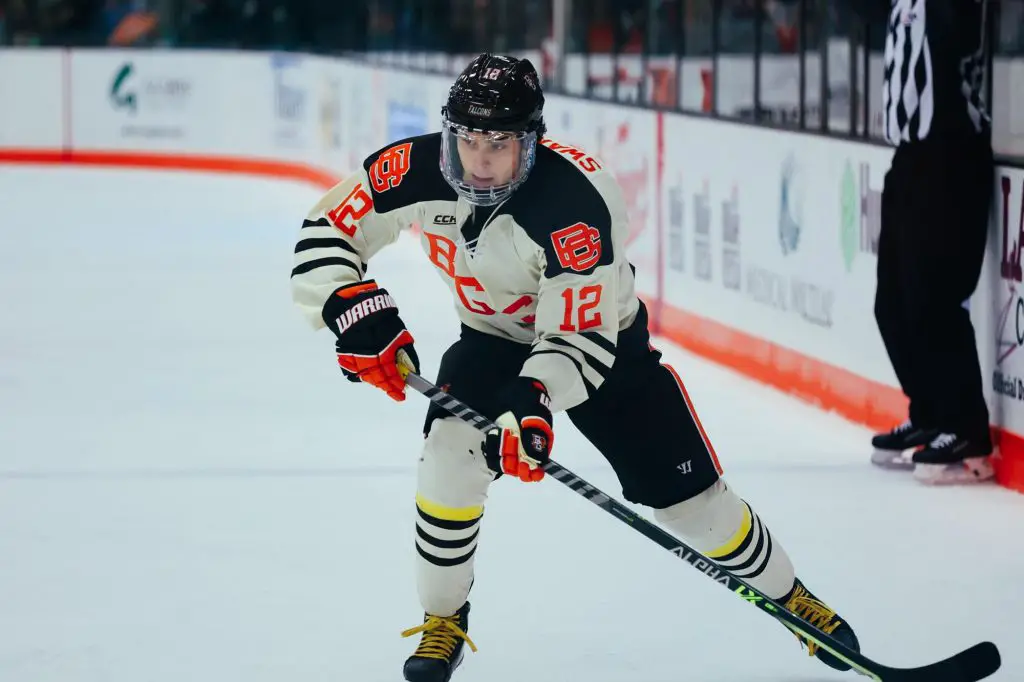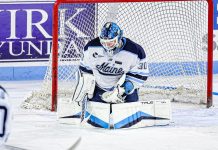
Each week during the season, we look at the big events and big games around Division I men’s college hockey in Tuesday Morning Quarterback.
Paula: Jimmy, it’s great to be working with you again this season and to throw around the college hockey talk the way we do.
While there’s a lot to discuss about the current season, I want to start with the NCAA’s decision to allow Division I eligibility for Canadian major junior players, starting with the 2025-26 season.
Dan Rubin and I talked about this a little in an earlier column this season when the proposal was still on the table. Honestly, I surprised myself with my own take about it. These are young players who gain so little financially from playing professional hockey that I am in favor of allowing them to play, especially now that players who opt for NCAA hockey without the major junior experience may be able to take advantage of NIL. I understand how few student-athletes playing hockey may benefit from NIL, but still.
In fact, one of my issues all along with Canadian major junior teams is how exploitive they can be, promising young players incentives – including tuition reimbursement – that may be unattainable given the terms of their contracts. That’s just one example.
What are your thoughts on how this will impact the Division I hockey landscape and the game itself?
Jim: Well, first off, great to be back with you on TMQ yet again!
I don’t think anyone can accurately predict the impact this ruling will have. Ed and I will speak with Sean Hogan from College Hockey Inc. on our USCHO Spotlight podcast this week and I think that will be revealing.
Where I see the biggest challenge for CHL players joining college hockey is what those players do to maintain their eligibility while playing major junior. Will they keep attending high school and maintain the minimum grade-point average to qualify for the college of their choice? That’s been one of the biggest points coaches have addressed with me thus far.
The other point to consider is how leagues like the OHL, WHL and QMJHL will react. What will they tell players? I am sure as players age out of that league, there will be some coaches who encourage players who aren’t ready for the pro game to head to an American college team?
But what happens when a college team poaches an elite 17- or 18-year-old from those leagues? All of a sudden, the relationship between college and major junior could become a little more tarnished.
We projected on USCHO Weekend Review that it will take 3-5 years to see what the impact of this decision is. Do you agree?
Paula: I do see the potential for an even more acrimonious relationship between major junior hockey and the NCAA.
I found the wording of the statements from the different major junior leagues interesting, especially OHL commissioner Bryan Crawford, who said, in part, “The OHL will continue to maintain a high standard as a leading supplier of talent to the National Hockey League.”
I know I’ll be accused of parsing language here, but this only enforces my rather negative opinion of major junior leagues – and the OHL specifically – who see themselves only as suppliers of talent, and who see young humans only as commodities. I understand the difference between major junior leagues and the NCAA. The leagues are businesses, and for all the criticism that people heap on the NCAA – sometimes justifiably – the NCAA is not, at least at the core of its mission.
In contrast, the statement from the USHL reads in part, “All aspects of the league are focused on preparing athletes for collegiate and professional hockey, inclusive of on-ice, academic and character development.”
You are completely correct, Jimmy, in bringing up all of the questions you pose. As many people know, I teach college English and the part of the USHL – and the NCAA – mission that addresses the well-being of student-athletes is something that I think is one of the primary goals of all college athletics. Will major junior leagues be forced to address the off-ice development of players – academics especially, but also the mental and emotional development of some pretty young guys – to boast in the future that they placed X number of students at X number of elite D-I schools? I mean, I don’t see them doing any of that for altruistic reasons.
Or will D-I programs who sign players from the major juniors be forced to vet potential recruits differently and perhaps do more off-ice developmental work with players who go that route?
I wish I had answers to these questions, but my crystal ball isn’t working well right now. As for your last question, though, I do agree. Based on what we’ve seen from the portal – and from the additional COVID eligibility, even though that’s going away – it will take at least three years to see the real impact of this decision, both on the ice and off.
One aspect of D-I hockey that I think it may affect – and I do mean “may” – is the further divide between the haves and have nots. I think this is something that all of us at TMQ – you, Ed Trefzger, Dan Rubin and I – have touched on this season to some extent, and in varying contexts. In October, you and Ed talked a little in a TMQ about the “tiers” in college hockey, the hows and whys of them and the implications for the future.
In the here and now, though, it seems evident to me that there is some separation occurring this season. I’m looking at the starts that Denver, Boston College and Minnesota have had, specifically, plus a handful of other teams who are starting well but perhaps not as decisively. I know it’s mid-November. I know how early it is. Do these – and other – early performances indicate that some teams are poised to pull ahead and dominate for the duration, or is it just too soon to tell?
Jim: Before I answer your closing question, I wanted to make one more point on major junior and it has nothing to do with how the CHL leagues and teams will respond.
I see a trickle-down impact on other junior leagues and players, the result of which could hold a positive in the overall landscape of hockey.
If more college players come from the CHL, maybe less players head to really low-tier junior leagues when players are younger (let’s think 8-15 year olds as opposed to 16-18). Right now, I consider our hockey development system in a state of crisis with far too many parents spending thousands of dollars when kids are eight, nine and 10 years old.
As a youth hockey parent, I’d love to see some of those leagues self-destruct. I miss the days when high school hockey was a competitive and enjoyable product (outside of the state of Minnesota, where it is still elite – though some players still leave for junior hockey).
I think this decision could influence players either to develop closer to home or head to a CHL team in one of the major junior leagues. That could be a benefit.
As for your question about blue bloods, I’m actually less concerned about this ruling on creating a haves and have nots situation. I could be wrong, but I see a larger player pool differentiating the coaching staffs at all 64 Division I schools. The best recruiters now have more players to choose from and will find a way to not rely only on, say, the USHL for the top-tier talent.
Paula: I second your point about those low-tier junior leagues, Jimmy, and I share your hope that the trickle-down effect does what you anticipate it can do.
I do want to get back to my last question, though, which is about this season and the tiers that are developing right before our very eyes (at least in my mind) and not future impact of the recent major junior ruling.
Looking back at a month of TMQs, it seems to me that all four of us have touched in some way on parity as well as separation. I think we can all agree that college hockey is deeper – so to speak – than it was even a few years ago. For my Big Ten column last week, I talked to Bob Motzko about Minnesota’s quick start, and two things he said really struck me. The first was that just a few years ago, “there were probably eight or nine teams that had a true chance to win a title,” but now there could be 15 or 16 “that have a true chance to win it.”
Obviously, that addresses the parity we’ve seen in the national tournament in recent years, but the second thing he said that sticks with me still is this: “You don’t win championships early, but you could lose them.”
There are a number of teams here in the early going off to such fast starts, I’m wondering if they’re already positioning themselves to make it nearly impossible to miss the tournament.
I’m also wondering if that’s a dichotomy – that parity in a one-and-done tournament makes the season-ending PWR irrelevant.
Jim: I think that Motzko quote is interesting because I maybe feel differently. I guess the key is how Bob Motzko defines a “few” years ago.
I have felt since around 2010 or so, that we’ve had more teams than ever capable of winning a national title. Ferris State made the 2012 finals, Yale won in 2013, Union in 2014 and Providence in 2015.
Yes, Quinnipiac won two years ago, but the Bobcats had been on the uptick leading in, losing in the finals in 2013 and 2016.
I actually don’t feel as hopeful that, say, we’d have a first-time national champion this season, just looking at the current USCHO.com poll (and granted, not my favorite measuring stick).
As for teams already positioning themselves for an NCAA bid, I think you’re correct. We have a few already. Denver is 10-0-0 out of conference, they’d have to collapse in NCHC play to miss the NCAAs. Boston College is 7-1-0 but has six wins over top 20 teams and five over top 15 teams. Same can be said for Minnesota. With a 9-1-0 record to this point, they’d need to really struggle with B1G opponents.
My podcast co-host Derek Schooley doesn’t like me handing out NCAA bids at this point and says if all the teams I say “will make it,” we’d need a 22-team field. I get it. But we’re seeing a lot ironed out nationally very early this season.


